
 Data Structure
Data Structure Networking
Networking RDBMS
RDBMS Operating System
Operating System Java
Java MS Excel
MS Excel iOS
iOS HTML
HTML CSS
CSS Android
Android Python
Python C Programming
C Programming C++
C++ C#
C# MongoDB
MongoDB MySQL
MySQL Javascript
Javascript PHP
PHP
- Selected Reading
- UPSC IAS Exams Notes
- Developer's Best Practices
- Questions and Answers
- Effective Resume Writing
- HR Interview Questions
- Computer Glossary
- Who is Who
Types Of Activation Functions in ANN
This article we will learn about ANN and its types. We will also see programs on different types of Activation. Before diving into the types let's get to know what ANN is.
ANN
Artificial neural network (ANN) is a branch of machine learning which performs computation by forming a structure of biological neural network where each neuron can transmit the signal or processed data to other connected neurons. This structure is similar to the human brain in which neurons are interconnected to each other. Neural network is created when a connection of nodes or neurons forms a connection. Artificial Neural Networks are kinds of models which work similar to the human nerve system.
There are Three Layers of ANN
Input layer
In this layer we give input as data into the neural network. The number of neurons in this layer is same as the number of features in the data.
Hidden Layer
This layer is called hidden because this is the layer where the data is processed and the layer is hidden behind the input layer. The output of this layer will get transferred to the output layer.
Output Layer
This layer is where the output of the network is produced.
The neurons in each layer are connected to each other with weights. The weights are adjusted during training so that the network can learn to produce the desired output.
Representation of the ANN network
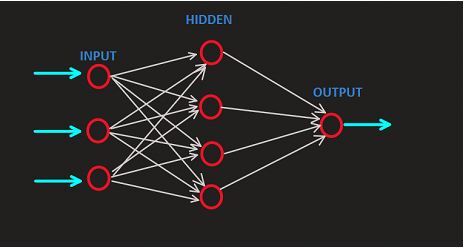
The above image diagram represents the neural network where the first layer is the input layer where we provide the data to the model and after its manipulation it will forward the output to the hidden layer which is present after the input layer. The outcome which will come out from the hidden layer will be given as output from the output layer. Each of the neurons has its weight assigned to it which represents the strength of the input value.
Types of Activation Function in ANN
There are many types of activation functions present in ANN, but we will see the functions which is used mostly
Sigmoid Activation Function
This activation is non-linear function in ANN which is used to map the input data to the value between 0 and 1 which denotes the probability. This activation function is used in the binary classification problems as an output layer.
Example
import numpy as np
import matplotlib.pyplot as plt
def sigmoid_Activation_fun(inp):
return 1 / (1 + np.exp(-inp))
inp= np.linspace(-10, 10, 100)
# applying sigmoid function
out = sigmoid_Activation_fun(inp);
plt.plot(inp, out)
plt.xlabel('Input')
plt.ylabel('Output')
plt.title('Sigmoid Activation Function')
plt.show()
Output
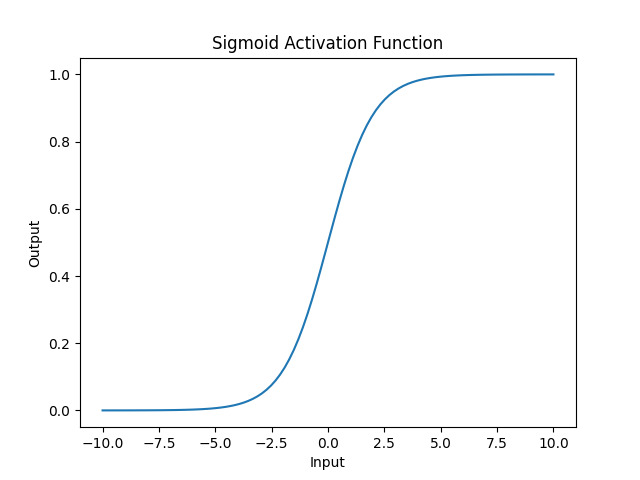
Rectified Linear Unit (ReLU)
ReLu is used widely among all other activation functions which brings non-linearity by mapping negative values to 0 and leaving the positive value unchanged. It provides much fast-learning during training and avoids the vanishing gradient problem. Compared to other activation functions like Tanh and sigmoid it provides better performance.
Example
import numpy as np
import matplotlib.pyplot as plt
def relu_activation_fun(inp):
return np.maximum(0, inp)
inp = np.linspace(-10, 10, 100)
# Applying the ReLU
out = relu_activation_fun(inp)
plt.plot(inp, out)
plt.xlabel('Input')
plt.ylabel('Output')
plt.title('ReLU Activation Function')
plt.show()
Output
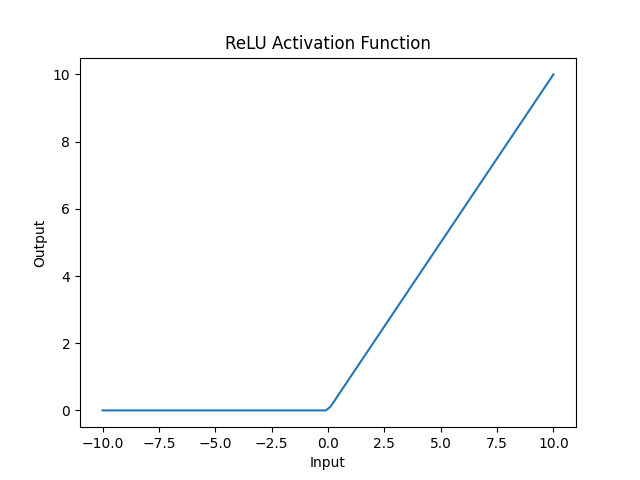
Hyperbolic Tangent (Tanh)
Hyperbolic tangent function, which is also called tanh function and we use it same as the sigmoid function and maps input values into a range of -1 to 1. THis activation function is mostly used in the hidden layer of ANN.
Example
import numpy as np
import matplotlib.pyplot as plt
def Hyperbolic_tanh_fun(inp):
return np.tanh(inp)
inp = np.linspace(-10, 10, 100)
# Applying tanh activation function
out= Hyperbolic_tanh_fun(inp)
plt.plot(inp, out)
plt.xlabel('Input')
plt.ylabel('Output')
plt.title('Tanh Activation Function')
plt.show()
Output
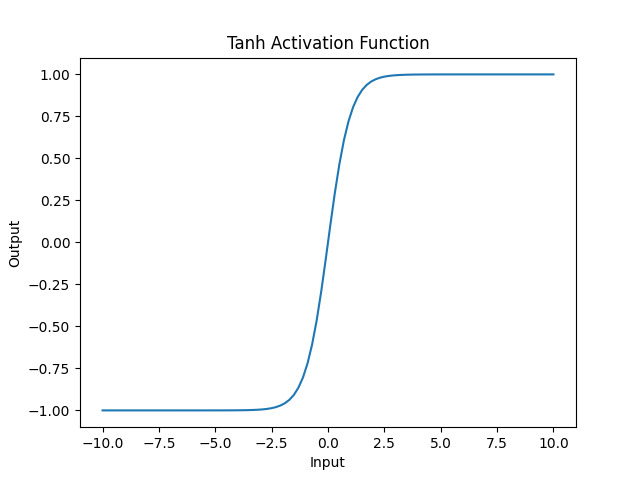
Leaky ReLU
This is a modified version of the ReLU function where the ReLU was setting the small value to 0 but this will allow the small negative value. This modified version improves the performance of the neural network.
Example
import numpy as np
import matplotlib.pyplot as plt
def leaky_relu(inp, alpha=0.01):
return np.where(inp >= 0, inp, alpha * inp)
inp = np.linspace(-10, 10, 100)
# Applying leaky ReLU activation function
out = leaky_relu(inp)
plt.plot(inp, out)
plt.xlabel('Input')
plt.ylabel('Output')
plt.title('Leaky ReLU Activation Function')
plt.show()
Output
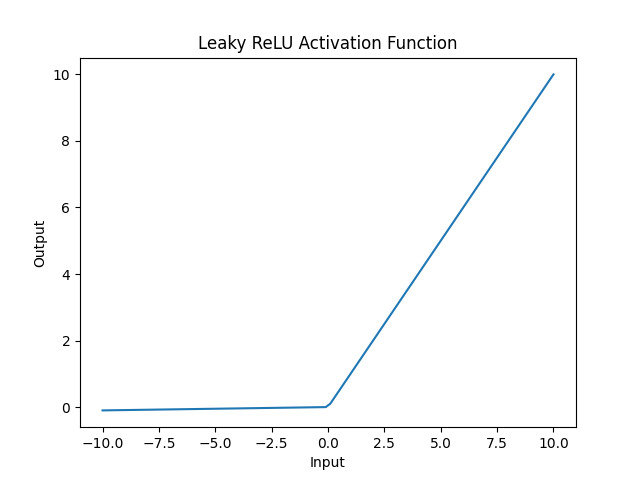
Softmax Activation Function
The softmax activation function is a type of activation function using which we compute probability distribution and it ensures that the sum of these probability comes out to be 1. This activation function is mostly used in the output layer of multi-class classification problems.
Example
import numpy as np
import matplotlib.pyplot as plt
def softmax_activation_function(inp):
exps = np.exp(inp)
return exps / np.sum(exps)
inp = np.array([1, 2, 3, 4, 5])
# Applying softmax activation function
out = softmax_activation_function(inp)
plt.bar(range(len(inp)), out)
plt.xlabel('Class')
plt.ylabel('Probability')
plt.xticks(range(len(inp)))
plt.title('Softmax Activation Function')
plt.show()
Output
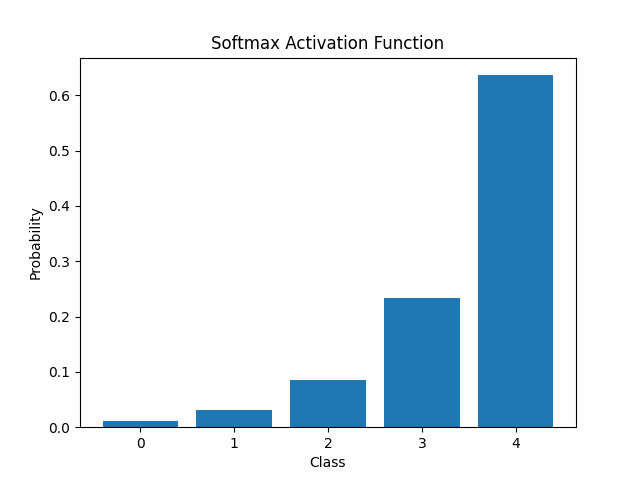
We usually choose the activation function based on the requirement of the problem which we want to solve and the output of ANN. Like tanh and sigmoid functions are often used in classification problems whereas ReLU functions are often used in regression problems.
Conclusion
So, we get to know about ANN and its types. We saw various types of activation functions like sigmoid function, ReLU, tanh, leaky ReLU in ANN and its usage. To use the activation function suitably we must have the knowledge of it to build artificial neural network models. Every activation function has its unique properties, working mechanism, behavior and training process. We can use these functions in our ANN task to enhance the model.

